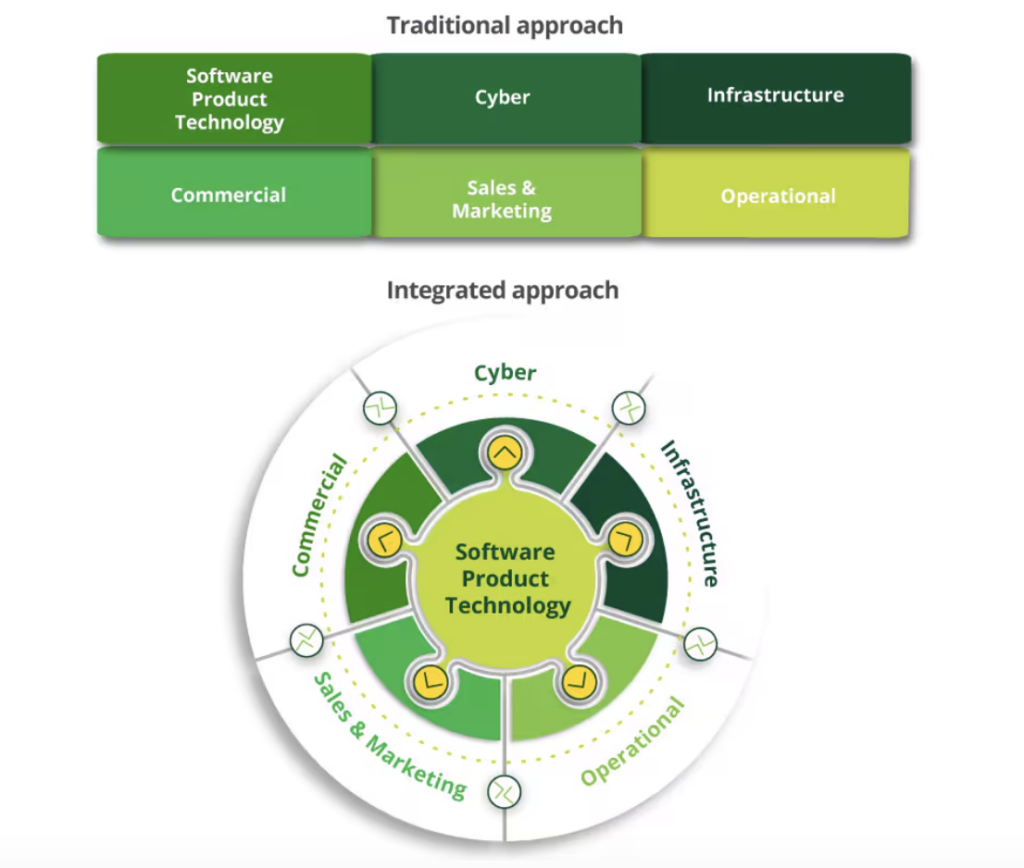Corporate mergers and acquisitions (M&A) are high-stakes transactions where companies combine forces or assets, navigating complex financial, legal, and cultural landscapes.
Effective negotiation, such as balancing price, risk, and stakeholder alignment, often determines success. From anchoring valuations to bridging information gaps with digital tools, strategic preparation and psychological agility turn volatile talks into value-driven outcomes.

Understanding the dynamics of M&A negotiations
M&A negotiations are shaped by competing priorities, intricate deal structures, and intense scrutiny. Success hinges on navigating these dynamics strategically. Below, we dissect the core challenges that define M&A negotiations.
High stakes and financial implications
M&A deals often involve billions of dollars and long-term strategic consequences. The pressure to maximize value while mitigating risks, such as overpaying or underestimating liabilities, may force negotiators to struggle between ambition and caution.
For instance, Disney’s $71.3 billion acquisition of 21st Century Fox required balancing shareholder expectations and antitrust regulations. Disney divested Fox’s regional sports networks and adjusted media ownership limits, while assuring shareholders of long-term growth through expanded content libraries and global streaming dominance.
Conflicting stakeholder interests
Deal parties may not share identical goals. Sellers often aim to maximize valuation in mergers and acquisitions, while buyers usually focus on minimizing costs and uncovering hidden risks. Employees, investors, and regulators also add complexity to the transaction negotiation process. Successful conflict resolution demands transparent communication and compromise. This approach has been observed in companies that have consistently extracted significant value from mergers and acquisitions.
Cross-border M&A hurdles
Cross-border deals often face delays due to varying legal frameworks and competition concerns. Regulators like the Securities and Exchange Commission (SEC) or European Commission may impose strict conditions. For example, Microsoft’s protracted $68.7 billion acquisition of Activision Blizzard highlights how cross-border antitrust scrutiny can delay deals.
Information asymmetry and trust gaps
Sellers often possess more insights about their company’s risks than buyers, creating power imbalances. However, thorough due diligence, supported by robust deal analytics, can help to bridge this gap. Negotiators should also be cautious of ethical dilemmas, such as disclosing liabilities, which can erode trust if not managed transparently.
Preparation strategies for successful M&A negotiations
Below, we outlined actionable strategies to ensure negotiators enter discussions armed with clarity, data, and foresight:
Align objectives and understand stakeholder motivations
Every M&A deal involves divergent priorities, and it’s crucial to balance motivations and objectives of selling and buying shareholders. For example, when Microsoft negotiated its $26.2 billion LinkedIn acquisition, it balanced LinkedIn’s desire for autonomy, retaining LinkedIn’s CEO, distinct brand, and corporate culture.
Negotiators should begin by mapping stakeholders’ core interests and identify overlapping incentives to anchor negotiations. This can help avoid win-lose negotiations, where one party gains significant value at the expense of another.
Set non-negotiables and define BATNA in negotiations
Establish clear boundaries early. Determine your Best Alternative to a Negotiated Agreement (BATNA) to avoid unfavorable concessions. BATNA refers to a negotiator’s strongest fallback option if talks collapse, empowering them to reject unfavorable terms by setting predefined walk-away conditions (e.g., regulatory approvals, price caps) during high-stakes M&A deals.
Conduct comprehensive due diligence
A thorough due diligence process uncovers risks, validates assumptions, and informs negotiation leverage. It ensures a buyer has a sound valuation analysis before negotiations begin. World’s largest consulting firms, such as Deloitte, emphasize a multi-dimensional approach — integrating multiple due diligence streams and developing a corresponding M&A document checklist:
| Due diligence stream | Sample due diligence checklist item |
| Financial statements |
Balance sheets |
|
Income statements |
|
|
Cash flow trends |
|
|
Debt schedules |
|
|
Off-balance-sheet liabilities |
|
|
Contingent obligations |
|
|
EBITDA margins |
|
|
Revenue recognition policies |
|
|
Historical audits |
|
|
Working capital adequacy |
|
|
Capital expenditure forecasts |
|
| Market position |
Customer concentration |
|
Customer churn rates |
|
|
Brand loyalty |
|
|
Competitor benchmarking |
|
|
Market share trends |
|
|
Growth projections |
|
|
Disruptive threats |
|
|
Patent landscapes |
|
|
Environmental, social, governance (ESG) factors |
|
| Legal risks |
Pending litigation |
|
Regulatory compliance (SEC/FTC/GDPR) |
|
|
Contractual breaches |
|
|
Intellectual property ownership |
|
|
Licensing agreements |
|
|
Export controls |
|
|
Antitrust exposure |
|
|
Data privacy compliance |
|
|
Environmental regulations |
|
| Operational risks |
Supply chain dependencies |
|
IT infrastructure |
|
|
Cybersecurity protocols |
|
|
Maintenance schedules |
|
|
R&D pipelines |
|
|
Quality control processes |
|
|
Overlaps in facilities, technology, or production capacity |
|
| Human resources risks |
Employee turnover rates |
|
Retention plans, and union agreements |
|
|
Compensation structures |
|
|
Pension liabilities |
|
|
Severance obligations |
|
|
Leadership alignment |
|
|
Succession plans |
|
|
Cultural integration challenges |

Create a cross-functional negotiation team dynamics
Assemble experts to address technical, legal, and cultural nuances. Include external financial analysis in your M&A process, leverage legal advisors (e.g., PwC or KPMG), and integration specialists. For cross-border deals, involve regional consultants to navigate local regulations.
Anticipate scenarios and stress-test assumptions
Model best-case, worst-case, and base-case scenarios. Stress-test financial projections, regulatory hurdles (e.g., European Commission approvals), and other obstacles on the M&A process timeline. For example, during Verizon’s Yahoo acquisition, unanticipated data breach liabilities slashed Yahoo’s value by $350 million — a risk better managed through proactive scenario planning.
Key M&A negotiation tactics and strategies
While preparation sets the stage, execution determines success. Below, we explore the top negotiation tactics in M&A that help parties secure favorable terms, bridge valuation gaps, and mitigate risks.
Anchor the conversation with strategic framing
First offers often set the tone for the deal negotiation. By anchoring discussions around a well-researched valuation range or term sheet, you can shape the counterparty’s expectations. For example, when Amazon acquired Whole Foods, it anchored the $13.7 billion deal around logistics synergy and customer base expansion, sidelining debates about the grocer’s declining margins.
Key tactics:
- Present data-backed valuations, ideally using multiple valuation methods (e.g., EBITDA multiples, discounted cash flows).
- Highlight unique synergies (cost savings, market access) to justify your anchor.
- Use third-party reports (from firms like Goldman Sachs or Deloitte) to validate claims.
Leverage BATNA to strengthen bargaining power
Your BATNA can be your safety net. Presenting alternatives can pressure the other party to complete the transaction, strengthening your negotiating position.
Key tactics:
- Privately secure backup options (e.g., alternative acquisition targets).
- Signal (without bluffing) that walking away is feasible. This way, you can maintain leverage at the bargaining table while adhering to ethical negotiation practices, fostering trust and mutual respect.
- Use deadlines to pressure indecisive sellers.
However, these business acquisition tactics often become less effective in seller’s markets, where multiple potential buyers create competitive tension. It is when competing offers become the seller’s BATNA. For example, when Disney bid for 21st Century Fox, Comcast’s $65 billion counteroffer forced Disney to raise its bid to $71 billion to remain competitive. In such scenarios, sellers capitalize on buyer urgency, leveraging alternative bids.
| Additional reading: Learn more about the M&A sell-side process in our dedicated article. |
Use earnouts to bridge valuation gaps
Valuation disagreements are known to derail M&A deals. Earnouts, which are future payments tied to performance metrics, can resolve this by aligning risk and reward, ultimately creating a win-win scenario. For instance, Pfizer structured earnouts in its Biohaven acquisition, linking approximately $740 million to future milestones. It’s important to structure tangible and efficient earnouts. Consider the following aspects:
- Metric selection. Tie payments to measurable, controllable outcomes (e.g., revenue targets).
- Timeframe. Limit earnout periods to 2–3 years to avoid prolonged disputes.
- Escrow accounts. Hold funds in escrow to ensure compliance.
- Pitfalls. Avoid vague metrics (e.g., “strategic synergies”) that invite litigation.
Negotiate non-price terms for hidden value
Price isn’t the only lever. Savvy business negotiators trade concessions on governance, employment terms, or liability caps to extract value.
Key tactics:
- Employment agreements. Secure key talent retention (e.g., Microsoft retained LinkedIn’s CEO post-acquisition).
- Indemnification clauses. Limit post-closing liabilities (e.g., environmental cleanups).
- Governance rights. Negotiate board seats or veto powers for critical decisions.
Employ “contingent payments” for risk sharing
Similar to earnouts, contingent payments link deal value to post-merger performance but are tied to external triggers such as regulatory approvals, litigation outcomes, or macroeconomic shifts.
To avoid ambiguity, these triggers must be explicitly defined in the purchase agreement. For example, a buyer may stipulate that a $500 million price reduction applies only if unresolved litigation exceeds a specific financial threshold.
Bring in third-party validators
Neutral experts, such as appraisers, consultants, or legal advisors, usually add credibility and provide important legal considerations in M&A deals. When to use third-party validators:
- Valuation analysis (leverage services like S&P Global Market Intelligence for research)
- Disputed valuations (hire independent appraisers).
- Regulatory hurdles (consult SEC compliance experts).
- Cultural clashes (engage integration planning consultants).
Counter “lowball” tactics with data-driven pushback
Sellers often undervalue liabilities or overstate synergies. To counteract this, you can prepare counterarguments using due diligence insights. You can cite specific risks uncovered in audits (e.g., pending litigation, declining market share) and reference industry benchmarks (e.g., “Your EBITDA margin is 15% below peers”).
Psychological aspects of M&A negotiations
Strategic negotiations are as much about human behavior as they are about numbers. Understanding cognitive biases and emotional intelligence can mean the difference between a derailed deal and a mutually beneficial agreement. Below, we dissect the psychological forces at play:
Cognitive biases that derail deals
Negotiators may fall prey to mental shortcuts that distort decision-making:
- Anchoring bias. Over-reliance on initial offers. For example, a company’s aggressive opening bid in a competitive auction can set a psychological benchmark, pressuring rival bidders to submit inflated counteroffers that exceed prudent financial thresholds.
- Confirmation bias. Seeking data that supports preexisting views. A buyer might ignore red flags in due diligence to justify a coveted acquisition.
- Overconfidence. Assuming synergies will materialize effortlessly. Hewlett-Packard’s disastrous Autonomy acquisition stemmed from underestimating integration complexities.
Emotional intelligence: The unseen advantage
Self-awareness, empathy, and emotional regulation can help M&A parties navigate high-stakes talks. Dealmakers with strong negotiation skills:
- Read non-verbal cues. Detect hesitation or enthusiasm through body language.
- Build trust and prioritize transparent communication. Leaders who emphasize openness during high-stakes acquisitions can foster goodwill and ensure mutually beneficial outcomes, even when there are valuation differences.
Managing ego and power dynamics
Egos often clash in M&A, especially in cross-border or asymmetric deals. Here are a few effective tactics to neutralize friction:
- Neutralize hierarchies. Use inclusive language (e.g., “we” instead of “I”) to balance power, encourage open dialogue (even in uneven negotiations), and make agreements more constructive.
- Leverage reciprocity. Concede minor points early (e.g., timeline flexibility) to gain leverage on critical issues like a purchase price.
Using virtual data rooms (VDRs) for a successful negotiation
Ideals

- Access controls
- Built-in viewer
- Full-text search
- Auto-indexing
- Customizable branding
- Advanced Q&A
- In-app live chat support 24/7
- 30-second chat response time
Dealroom

- Access controls
- Built-in viewer
- Full-text search
- Auto-indexing
- Customizable branding
- Advanced Q&A
- In-app live chat support 24/7
- 30-second chat response time
Citrix

- Access controls
- Built-in viewer
- Full-text search
- Auto-indexing
- Customizable branding
- Advanced Q&A
- In-app live chat support 24/7
- 30-second chat response time
Box

- Access controls
- Built-in viewer
- Full-text search
- Auto-indexing
- Customizable branding
- Advanced Q&A
- In-app live chat support 24/7
- 30-second chat response time
Intralinks

- Access controls
- Built-in viewer
- Full-text search
- Auto-indexing
- Customizable branding
- Advanced Q&A
- In-app live chat support 24/7
- 30-second chat response time
In high-stakes M&A negotiations, virtual data rooms (VDRs) act as force multipliers, enabling faster decisions, stronger collaboration, and defensible deal terms. Below, we break down their tactical advantages for M&A professionals.
Robust security
M&A negotiations require transparency while maintaining confidentiality. Data rooms for M&A deals resolve this challenge by providing:
- Role-based permissions. Restrict access to sensitive files (e.g., financials, IP portfolios) to authorized stakeholders only.
- Audit trails. Track who viewed which documents and when. It’s critical for resolving disputes over disclosures.
- Dynamic watermarking. Deter leaks by embedding user-specific watermarks on downloaded files.
For example, in cross-border deals, GDPR-compliant virtual data rooms (VDRs) protect European employee data, mitigating regulatory risks and ensuring compliance throughout negotiations.
Accelerated due diligence = Negotiation leverage
Time is power in M&A talks. VDRs can shorten the M&A timeframes by accelerating due diligence and streamlining M&A communications with the following features:
- AI-powered search. Instantly locate critical clauses (e.g., change-of-control provisions) and extract valuable insights from voluminous contracts.
- Automated Q&A workflows. Structured question routing with customizable roles (e.g., submitter, coordinator) accelerates stakeholder discussions while maintaining an audit trail of clarifications, concessions, and deal-critical disclosures.
- AI-powered bulk redaction: Auto-mask sensitive data (PII, trade secrets) across documents in minutes, ensuring compliance without manual bottlenecks.
For example, a buyer who uncovers an undisclosed liability early through these tools can swiftly adjust negotiations, securing price reductions or tailored indemnification clauses before the seller has time to counter.
Streamlined post-agreement execution
Even after the definitive contracts phase, virtual data rooms (VDRs) facilitate seamless transitions with features such as:
- Secure data migration. Transfer critical files (e.g., employee records, tax documents) to the buyer’s systems without exposure.
- Integration roadmaps. Store post-merger integration plans in the VDR, aligning teams on timelines and deliverables.
- Audit-ready archives. Maintain a searchable repository of all negotiation records for compliance or litigation.
Key takeaways
- Negotiation preparation is paramount. Define BATNA, conduct multi-dimensional due diligence, and stress-test scenarios to uncover risks early.
- Leverage tactical frameworks. Anchor offers, structure earnouts, and negotiate non-price terms (e.g., governance rights) to align incentives.
- Master psychology negotiating skills. Counteract biases (anchoring, overconfidence) with emotional intelligence.
- Leverage tools. Use VDRs to secure data, accelerate due diligence via AI, and streamline post-deal integration.